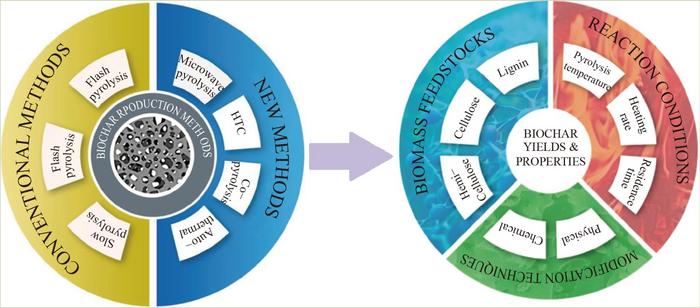Advancements in Biochar Production: Harnessing Lignocellulosic Biomass Pyrolysis for Environmental Sustainability
Biochar, a carbon-rich material derived from the pyrolysis of biomass under oxygen-limited conditions, has emerged as a pivotal player in environmental management and carbon sequestration strategies worldwide. This porous and structurally complex substance boasts remarkable adsorption characteristics, making it invaluable for soil remediation and ecosystem restoration. Moreover, its integration into agricultural soils has the potential to significantly offset global carbon emissions, with estimates suggesting that incorporating just 0.4% biochar annually into farmland soils could sequester carbon equivalent to 12 billion tons of CO₂. Despite its promising benefits, the scalability of biochar production remains hampered by elevated costs and inefficiencies inherent in traditional processing methods.
A transformative review conducted by Nguyen Xuan Loc and Do Thi My Phuong of Can Tho University in Vietnam explores how optimizing pyrolysis parameters can revolutionize biochar production from lignocellulosic biomass. This research, recently published in Frontiers of Agricultural Science and Engineering, meticulously evaluates both established and emerging pyrolysis technologies, offering insights into overcoming current limitations to produce high-quality biochar more efficiently.
Lignocellulosic biomass such as straw, forestry residues, and agricultural waste represents a plentiful and renewable source for biochar feedstock. However, conventional pyrolysis techniques—including slow, fast, and flash pyrolysis—each exhibit inherent trade-offs. Slow pyrolysis, characterized by gradual heating and extended residence times, consistently yields biochar with superior carbon content and structural integrity. Yet, it is time-intensive and energy-demanding. On the other hand, fast and flash pyrolysis prioritize rapid conversion to bio-oil, often at the expense of biochar yield and quality. These conventional methods lack precise control over product distribution and energy efficiency, challenging their widespread industrial adoption.
Emerging pyrolysis approaches introduce promising avenues to enhance biochar production efficacy. Microwave-assisted pyrolysis leverages rapid, volumetric heating through microwave radiation, substantially reducing processing time and energy consumption while improving reaction uniformity. Co-pyrolysis entails combining multiple biomass types, exploiting synergistic interactions that can tailor product composition and optimize material properties. Hydrothermal carbonization operates at relatively lower temperatures and accommodates feedstocks with high moisture content, broadening the range of viable biomass inputs. Additionally, auto-pyrolysis utilizes the exothermic heat generated during decomposition, minimizing external energy inputs and advancing sustainable, self-sustaining production loops. Collectively, these innovative technologies represent critical steps toward scalable and eco-friendly biochar synthesis.
A crucial focus of ongoing research is the manipulation of pyrolysis parameters to dictate the chemical and physical attributes of the resulting biochar. Temperature emerges as a principal variable; elevating pyrolysis temperatures intensifies aromatic carbon structures and fixed carbon fractions while expanding the specific surface area, thereby enhancing adsorption capacity. However, this often coincides with a decrease in overall biochar yield, illustrating the complex balancing act between quantity and quality. Similarly, adjusting heating rates and residence times can finely tune pore development, surface functionalities, and elemental composition, equipping biochar with targeted characteristics suited for specific environmental applications.
Beyond process optimization, post-production modification techniques further augment biochar functionality. Chemical treatments, such as acid or base activation, introduce or expose functional groups that enhance nutrient retention or pollutant adsorption in contaminated soils. Physical modifications—like steam activation or ball milling—can increase surface roughness and porosity, elevating interaction sites for contaminants or soil microbiota. These combined strategies not only expand the operational spectrum of biochar but also enable its tailored application in areas including heavy metal remediation, carbon capture, and soil fertility enhancement.
Understanding the interplay between feedstock properties, pyrolysis dynamics, and modification strategies is paramount to unlocking biochar’s full potential. Lignocellulosic materials vary widely in cellulose, hemicellulose, and lignin content, each decomposing at different temperature ranges and influencing char characteristics. Systematic exploration and standardization of process parameters promise to yield replicable, high-performance biochars that meet the exacting requirements of agricultural practitioners and environmental engineers alike.
Moreover, integrating real-time monitoring and advanced sensor technologies into pyrolysis systems can provide enhanced control over reaction environments, promoting consistent product quality and energy efficiency. Such advancements pave the way for modular and scalable biochar production units that align with circular bioeconomy principles and localized resource utilization.
The environmental implications of optimized biochar production extend beyond carbon sequestration. Its role in remediating degraded soils, reducing reliance on chemical fertilizers, and mitigating greenhouse gas emissions highlights its multifaceted contribution to sustainable agriculture and climate change mitigation. Scaling up efficient, cost-effective biochar manufacturing could become instrumental in achieving global sustainability targets.
Future research directions emphasize not only technological improvements but also life cycle assessments, economic feasibility studies, and field trials to validate biochar’s long-term efficacy under diverse agroecological settings. Policymaking and cross-sector collaboration will be essential to facilitate the adoption of optimized pyrolysis methodologies and realize biochar’s environmental promise.
In summary, the systematic optimization of pyrolysis parameters combined with innovative processing technologies and modification strategies hold the key to advancing biochar production from lignocellulosic biomass. This approach promises to overcome current economic and technical barriers, enabling large-scale applications that contribute to environmental restoration, climate change mitigation, and enhanced agricultural productivity.
By harnessing these scientific advancements, the global community moves closer to unlocking the vast potential of biochar—a material poised to redefine sustainable soil management and carbon stewardship in the years ahead.
Subject of Research: Not applicable
Article Title: Optimizing biochar production: a review of recent progress in lignocellulosic biomass pyrolysis
News Publication Date: 14-Jan-2025
Web References: http://dx.doi.org/10.15302/J-FASE-2024597
Image Credits: Nguyen Xuan LOC, Do Thi My PHUONG
Keywords: Agriculture




